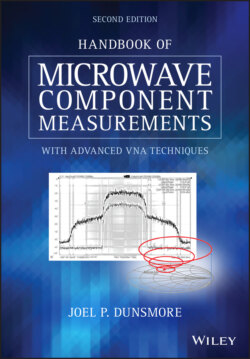Читать книгу Handbook of Microwave Component Measurements - Joel P. Dunsmore - Страница 110
2.2.5.6 Isolation and Crosstalk
ОглавлениеIsolation between VNA receivers is important when measuring high‐dynamic‐range devices such as filters. In almost all measurements, the reference path has a large signal (as it measures the incident wave) and so is a constant source of leakage signals. Partly for this reason, it is common to provide additional loss in front of the reference channel mixer (5 or 10 dB) to lower the incident signal level and provide greater reverse isolation for mixer bounce. This also helps to keep the reference channel mixer operating in its linear region for higher source power signals, avoiding compression in the reference mixer.
In fact, there are four primary crosstalk paths in VNAs, listed here:
1 RF signal from the internal source or reference receiver to the transmission test port. This crosstalk signal is independent of the DUT characteristics, and its level remains constant regardless of the DUT properties but will change with test frequency. Leakage of the reference mixer IF to the test mixer IF path has similar characteristics, but its value doesn't change with frequency.
2 RF signal from the reflection test receiver (b1) that leaks to the transmission test receiver. This signal depends upon the input reflection of the DUT; if the DUT is well matched, there will be no signal at the reflection receiver. Since this signal depends upon the DUT, correcting for it is more complicated.
3 RF signal that leaks from the test set switch, to port 2, and reflects off the DUT output match into the port 2 transmission test mixer. As this signal depends upon the DUT characteristics, correcting for it can also be more complicated. Modern VNAs that use separate sources instead of test set switches eliminate this source of crosstalk.
4 The final source of signal leakage is related to any test fixture or probing done to connect to the DUT. Leakage from port 1 to port 2 of the probes or fixtures is usually electric field radiation or magnetic field coupling between the ports. Since these fields are non‐TEM, they do not remain constant with changes in the DUT characteristics, and their effect may not be well understood. Probe‐to‐probe isolation is a key problem in measurements, but one that is not well accounted for. Careful fixture or probe design that includes shielding is perhaps the best solution to this final leakage effect.
In most modern VNAs, the design of the mixers and LO isolation networks are such that the level of the first three sources of crosstalk are at or below the noise floor of the receiver. As such they can be ignored except in special cases where extended dynamic range is desired, as discussed in Chapter 6. The fourth cause of crosstalk is inherent in the fixtures or probes, and it can sometimes be removed with calibration. But since the source is often due to radiation from one port to the other, this radiation pattern depends in a complex way on the actual loading of the port and the structure of the DUT. For example, in a probed situation, leaving the probes up as an “open” calibration standard can cause the probes to act as E‐field antennas and can produce crosstalk between the probes. Grounding the probes, to produce a short, can cause magnetic field coupling between the probes, again producing crosstalk. Both of these crosstalk terms are non‐TEM, meaning they have E and H fields that propagate in the direction from port 1 to port 2. Normal calibration methodologies do not correct for non‐TEM crosstalk as their values do not remain constant if the DUT configuration changes.
